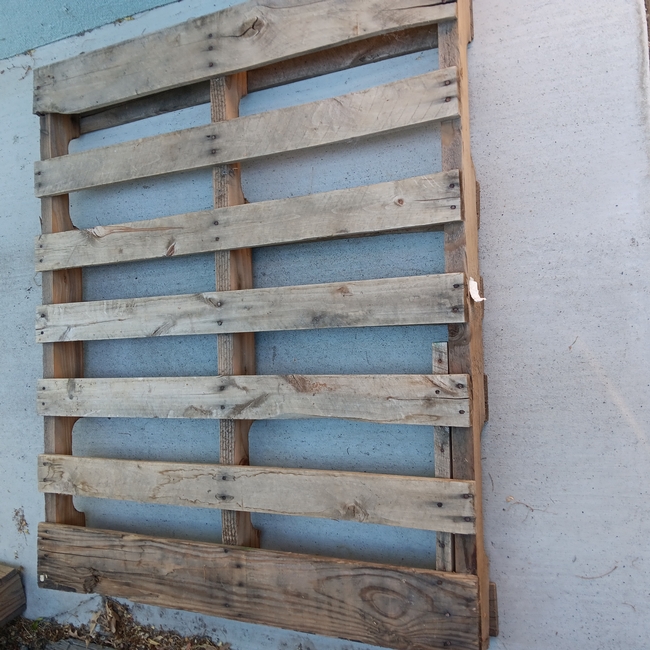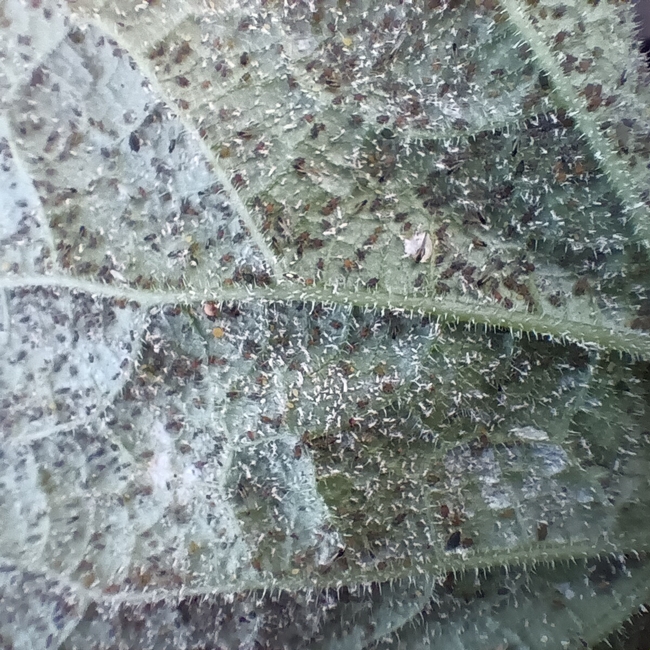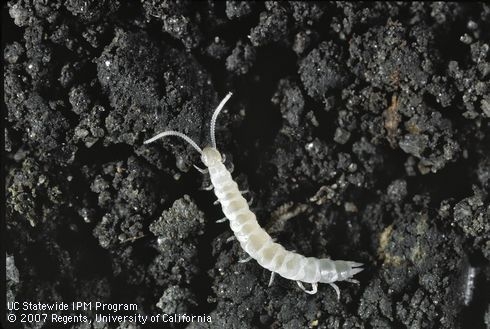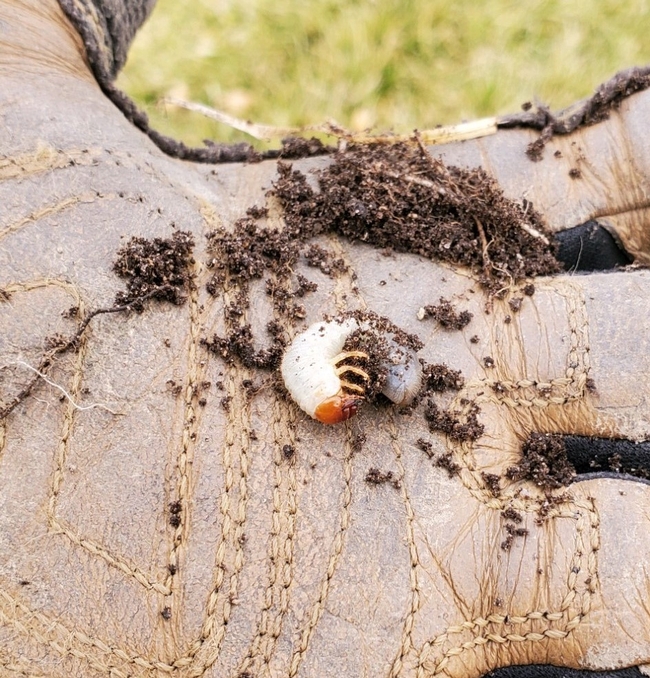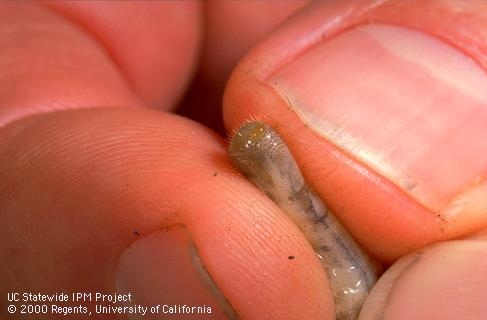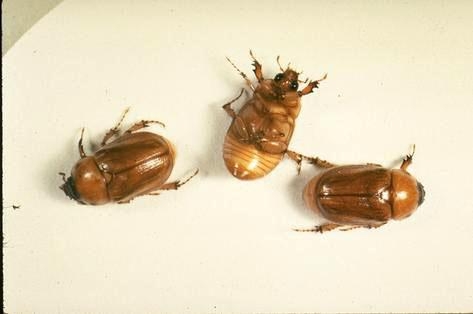- Author: Ryan Daugherty
Pallets are an attractive option for raised bed construction due to their affordability and availability. Often found discarded behind stores, at the dump, or sold cheaply, pallets provide a sustainable alternative to buying new lumber. Additionally, re-purposing pallets aligns with the principles of recycling and reducing waste which is never a bad idea to consider. Constructing raised beds from pallets can also add a rustic, charming aesthetic to your garden.
However, before you rush to build your raised beds from pallets, it's essential to understand the risks, especially when it comes to the treatment of the wood.
Pallets are designed for transporting goods, and as such, they are often treated to prevent the spread of pests and diseases across borders. The type of treatment a pallet has undergone is typically indicated by a series of markings found on the pallet's side. These markings provide crucial information that determines whether the pallet is safe for use in a garden, where the wood will come into contact with soil and plants. Keep in mind that a pallet may have one or a combination of these markings.
Pallets at the end of their lives, usually when gardeners acquire them, are often unmarked or in poor enough condition that markings or evidence of treatment are not obvious.
Here's a breakdown of the most common markings you may encounter:
The IPPC Logo. The IPPC (International Plant Protection Convention) logo is the most common marking found on pallets. It resembles a small tree symbol with an outline and is a part of the global standardization for wood packaging materials. This logo indicates that the pallet meets international shipping standards and has undergone treatment to prevent the spread of pests.
HT Pallets marked with an “HT” have been heat-treated. This process is popular in Canada and the United States. It involves heating the wood to a specific temperature for a set period, which kills any pests like fungi, or insects that might be present in the wood. Soft wood pallets are heated to a core temperature of 132°f, and 140°f for hard wood if you're interested. Importantly, no chemicals are used in this process, making HT pallets generally safe for garden use.
DB The “DB” marking indicates that the pallet wood has been debarked, meaning the bark was scraped off of the wood before it was milled. Debarking is not a treatment method but rather a process that makes the wood easier to work with and less susceptible to pests. Debarking has no effect on the chemical properties of the wood and as such is generally safe to use for lumber.
KD “KD” stands for kiln-dried, which is a process where the wood is dried in a kiln to reduce moisture content down to at least 19% or below. Kiln-drying helps prevent warping and splitting but does not indicate whether the wood has been treated with chemicals. Kiln-drying temperatures don't necessarily reach up to the level of heat treatments and so it isn't really considered a treatment for pest control. It's not uncommon to see code “KD-HT” indicating kiln-drying and heat treatment with both processes accomplishing something different. KD pallets are safe to use in gardening.
MB This is one that you want to watch out for! If you see the letters “MB” on a pallet, it indicates that the wood was treated with methyl bromide, a toxic chemical fumigant used to kill pests. Methyl bromide is a highly effective pesticide, but it's also toxic to both plants and animals. Pallets treated with this chemical should never be used in gardening, as the chemical residues can leach into the soil and be absorbed by plants, posing serious health risks to humans and animals. You will often see “MB” paired with other treatments like “DB-MB” meaning debarked and treated with methyl bromide, or “KD-MB” for kiln-dried and treated with methyl bromide for example.
Using chemically treated wood in your garden can lead to the contamination of your soil, which in turn can affect the health of your plants and pose risks to anyone consuming the produce. The leaching of toxic substances like methyl bromide can have long-term effects on soil quality, potentially rendering it unusable for safe food production.
While the IPPC logo and the accompanying treatment codes are the most common markings on pallets, you may also encounter regional markings or codes that provide additional information. For example, some pallets might include a country code (e.g., “US” for the United States) or a manufacturer's identification code. These additional markings can help trace the origin of the pallet, but they don't usually impact its safety for garden use.
It's important to note that some pallets, especially those used for domestic purposes or in certain industries, may not have any markings at all. There are still unmarked CCA-treated pallets circulating about, and you don't want to use them in your garden. In these cases, it may be best to err on the side of caution and avoid using the pallet for gardening unless you can confirm the pallet's provenance and treatments, if any. (That's unlikely.)
Markings or not, it's wise to check any pallet you intend to use for any signs of spills, stains, or unusual odors that might indicate contamination from the materials it previously carried. And some contaminants are colorless and odorless.
Using pallets as lumber for raised bed gardening is a sustainable and economical option, but it requires careful consideration of the wood treatment. Understanding pallet markings is essential to ensure the safety of your garden and the health of your plants. Always prioritize heat-treated (HT) pallets, avoid those marked with methyl bromide (MB), and thoroughly inspect any pallets before use.
If you are at all in doubt about your pallets' source or past, it's safest to use them for applications that do not involve edible crops. They can also be recycled! Inyo County Residents can take them to the Bishop or Big Pine drop offs. Mono County residents should contact their Solid Waste Department.
Keep in mind wood from pallets that are not chemically treated may not be long-lasting in the garden due to the moisture. Be prepared to maintain them as the boards wear out.
With the right precautions, pallet wood could be a valuable resource for your garden, contributing to a productive and environmentally growing space.
- Author: Alison Collin
This year I was determined to create the “model garden” that I have long dreamed about, but those dreams of neat, weed-free rows of vegetables, trees hanging with fruit, and armfuls of flowers are far from being fulfilled. In fact, I have had a garden of pestilence and disease on a scale that I have never faced before.
In accordance with modern ideas of “gardening with nature” last fall, I spread compost and rotted manure in liberal quantities. I left leaves on the ground in order to afford some protection to plants and beneficial insects in our high desert location. This resulted in my seeing the first grasshopper – a whopper – on January 26, followed shortly after that, by clouds of leaf-hoppers erupting from some mulch that I had put over my strawberry plants and blackberry roots. It was not apparent that the beneficial insects gained the same advantage.
Carefully nurtured spring transplants, often consisting of rare or unusual species were rapidly chewed to stubs before I had managed to get any protection set up. As the weather warmed a large crop of fence lizards appeared, and it gave me immense satisfaction to see grasshopper legs protruding from their mouths. Nothing seemed to eat the leaf-hoppers and spraying with horticultural oil failed to reduce their numbers.
The blossom on the fruit trees was a joy to behold until early May when a frost damaged the flowers and destroyed the early fruit set, so no plums, peaches, or cherries this year, and only a few pears. Potato shoots were frosted and a tomato which was covered with two layers of insulating cloth was cut to the ground.
I thought how pretty the gray foliage of the California poppies looked in the pollinator garden before I realized that they were suffering from a hefty dose of powdery mildew which also severely affected all the larkspur and older roses, although the modern hybrids were largely resistant. This problem, which likes dry conditions affected only one side of the house, while the better irrigated areas of fruit trees and vegetables showed no signs of it.
By early June it became evident that our irrigation system had problems. With drip irrigation, much of it is out of sight, and it is not always apparent when things go wrong. I lifted the lid of the irrigation vault and found it full of water and a mass of fibrous roots from the nearby grape vine which was growing vigorously. This led to a redo of the vault and installation of new valves. The grape immediately took umbrage at the disturbance, and the loss of roots and water and went into a state of shock; the leaves already much damaged by leaf hoppers crisped and the few bunches of grapes stopped swelling. Within a couple of weeks the vault had been invaded by a ground squirrel which had managed to follow a pipe into the vault and thrown soil all over the valves.
Through all this my usually trusty potatoes stopped growing and the foliage turned yellow and looked awful. I left them for a month to see if they would improve then began to dig them up. Each plant had a cluster of small potatoes with many enlarged lenticels - indicative of too much water. There were a lot of symphylans present so I suspect that they had damaged the roots or tubers somehow. The carrot patch had also received too much water so that the well grown ones have split from crown to root tip.
Low growing fruits – strawberries, figs, raspberries and blackberries began to disappear into the gut of the ground squirrel and various birds but netting the awkward shapes of all these plants was challenging and did not solve the problem. Next, a rat discovered the joy of eating grapes and most of the remaining bunches became bare stalks – a reminder of what could have been.
The annual thrips infestation of onions began early and I only managed partial control with insecticidal soap sprays. Luckily the onions don't look too bad. Rhubarb leaves were skeletonized by European earwigs, which also took a shine to the foliage of a precious new dahlia plant.
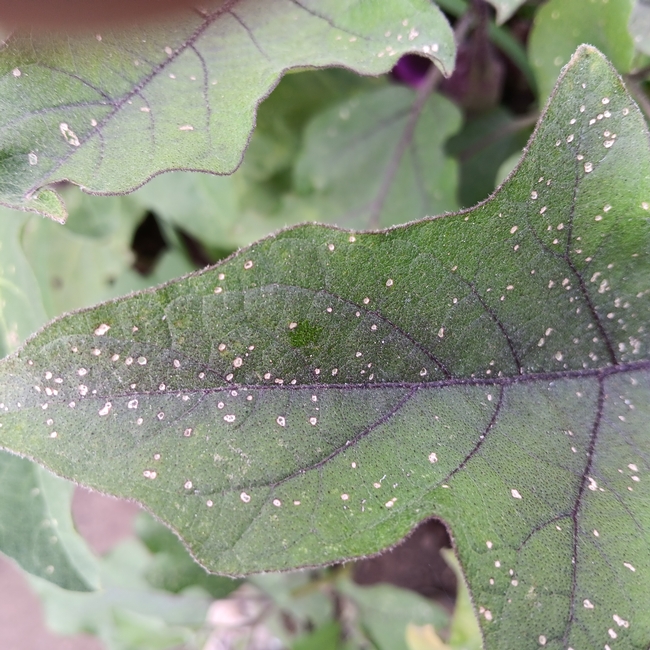
I tried to grow fillet French beans for the first time, but they very quickly became infected with a virus, some almost as soon as they got their first true leaves. Yesterday I noticed that my best Japanese eggplant is laced with holes from flea beetles and there are now large yellow patches on the newer leaves, possibly caused by some disease.
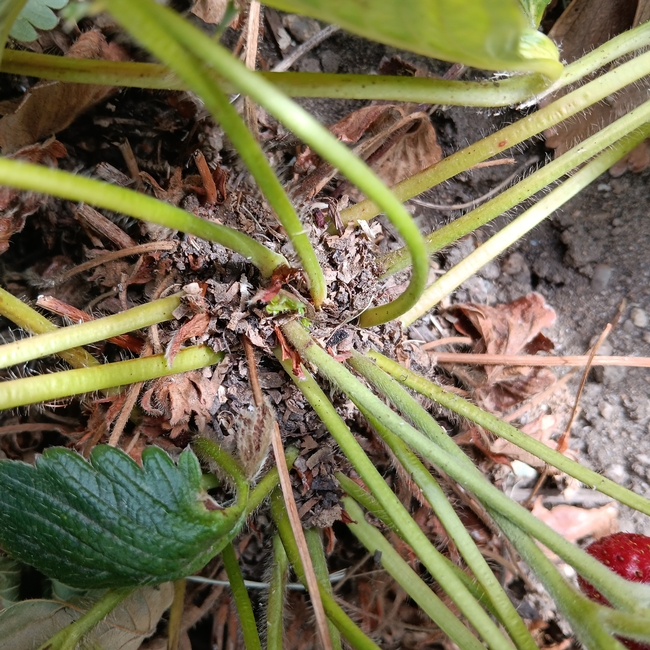
Ants have dominated every corner of the garden and one variety has taken to building mounds of organic matter over the crowns of the strawberry plants. The zucchini was taken over by one species of large ant. They were particularly drawn to the flowers, and although they prevented the squash bees from getting close, the ant must have pollinated the flowers since we had an excellent crop, and only one squash bug all summer! However, they have now started to farm aphids on this plant and also the nearby cucumbers which became so badly affected by sooty mold that I had to dispose of them. As it happens that is not such a loss since many of the cucumbers have been extremely bitter – a problem that I have never had before.
In the fourteen years that I have gardened in Bishop I have had very few serious pests or diseases, of any sort, apart from the ever present Bermudagrass, spotted spurge, and purslane which seem minor compared to the problems that this year has brought.
On the brighter side: My tomatoes have done well and stayed disease free so far, the pear tree seems to no longer be infected with blister mites or fireblight, there were few aphids on the peach trees and cherry and all the fruit trees have put a lot of energy into growth rather than fruiting, so I have had a restful summer, well away from the preserving pan, although now I have to get the pole pruner out!
You never know what's in store for one's garden. I hope that I will achieve my “model garden” next year...
- Author: Ryan Daugherty
Why Lawns Go Full Drama Queen During Droughts
Imagine being stuck in a sauna without a drink of water.
That's your lawn during extreme dry heat. Here are the main culprits:
- Lack of Water: Duh. When it's hot outside, your lawn needs more water. But with water restrictions and the general annoyance of hauling a hose around, many lawns just don't get enough.
- Soil Compaction: If your soil is as hard as a rock, water won't penetrate it. Roots can't grow, and your grass will starve for water.
- Poor Root System: Grass with shallow roots is like a teenager with a bad Wi-Fi connection—constantly in distress. Deep roots are essential for tapping into moisture reserves, but hot, dry conditions can prevent roots from growing deep.
Common Lawncare Blunders in the Heat of the Moment
We all make mistakes, but when it comes to lawn care in extreme heat, these common goofs can turn your yard into a crispy nightmare.
- Overwatering: Believe it or not, you can overdo it. Too much water can lead to shallow roots and fungal diseases. Plus, if water just sits on the surface, it can evaporate before it even reaches the roots.
- Underwatering: On the flip side, skimping on water is a sure way to send your lawn into a death spiral. Consistency is key, folks!
- Mowing Too Low: A short tight lawn might look neat, but it's a death sentence during drought. Longer grass shades the soil, keeping it cooler and reducing evaporation.
- Fertilizing During Drought: Fertilizing during extreme heat can burn your grass and make it extra crispy.
- Ignoring Soil Health: If your soil is more barren than a Monday morning coffee pot, your grass won't thrive. Healthy soil retains moisture better and provides essential nutrients.
Strategies to Survive the Lawn-pocalypse
Alright, enough with the doom and gloom.
Here's how to be the Lawn Whisperer and keep your yard looking fabulous, even when Mother Nature is throwing a tantrum.
- Water Wisely: Water deeply and infrequently. Aim for early morning watering sessions to reduce evaporation. If you have an automatic sprinkler system, set the times so that your sprinkler cycles are ending right as the sun comes up.
- Aerate Your Lawn: Give your grass some breathing room by aerating your lawn. This reduces soil compaction and allows water to penetrate deeper. It's like giving your lawn a spa day. Try not to do it when your lawn is stressed, spring and fall are best.
- Mow High: Set your mower blade to the highest setting. Taller grass shades the soil, retains moisture, and promotes deeper root growth. Your lawn will look thick and lush in no time. Like aeration you should avoid mowing spots of stressed grass, it's only going to damage the lawn more.
- Soil Care: Improve your soil's health by adding organic matter like compost. Healthy soil holds onto water better and provides essential nutrients to your grass.
- Avoid Fertilizing During Drought: Hold off on the fertilizer until conditions improve. Focus on watering and soil care instead. When the weather cools down, your lawn will be ready for a nutrient boost.
- Monitor and Adjust: Keep an eye on your lawn's condition and adjust your care routine as needed.
- When all else fails let it go dormant. It may not look great but the reason your lawn looks brown and crispy is because it's going dormant and protecting the crown to come back when conditions improve. If you can't provide enough water to consistently keep the grass healthy it's better in the long run to let it go dormant rather than to provide inconsistent health that drains resources that the grass will need to recover later. Grass can survive for weeks in that state but if you're going to let it go dormant, provide sufficient water every two weeks or so to keep the roots from drying out completely.
You may notice a shift in turf species growing in your lawn after a spell of drought and dormancy due to differences in stress tolerance, especially for a prolonged drought.
Embrace the Chaos?
Let's be real—sometimes, despite your best efforts, your lawn might still look like it's auditioning for a zombie movie. And that's okay, droughts are tough!
Remember, the key to surviving a Lawn-pocalypse is to stay calm. The lawn could just be responding to environmental stress, but with a little TLC and some strategic care, you can help your lawn bounce back.
Keep hydrated (both you and your lawn), and maybe learn to love a little bit of brown.

- Author: Dustin W Blakey
I know you've seen them. Little caps on the end of vertical irrigation pipe that can be adjusted to control flow with a twist (or screwdriver). They are called flood bubblers and are used widely in the Eastern Sierra to deliver water to woody plants outside of a lawn sprinkler system.
Unfortunately, I see more tree problems caused by this type of irrigation than any other single cause of tree death in our area. Many dead or sick trees in our area have been irrigated (insufficiently) by flood bubblers.
What are bubblers for?
Bubblers have a few important uses and benefits. They are good at watering young trees during establishment since the water is concentrated near the root ball. In the right types of soil, they can also be good at watering shrub beds or large tree wells if the output can exceed the soil's infiltration rate. They flood the soil with water. When there is a berm or wall around the bed, and if you can fill it, bubblers are a fine choice.
In general, as a source of water there really is no problem with their use. They are cheap and low maintenance. The lack of spray helps to prevent water lost to evaporation while they are running.
The issue is how we use them locally over the long haul.
Bubblers are not drip systems
The purpose of a bubbler-type emitter is to deliver a high output rate of water to a concentrated area, like a single, young tree. I often see one bubbler per tree. The shape of the bubbler takes away some of the kinetic energy of the flow and allows a gentle flood that hopefully will not disturb or erode the soil.
Many bubblers here are used as a substitute for a drip emitter. This is the beginning of the problem. Bubblers are designed to deliver about 2 gallons per minute, whereas a single drip emitter is usually closer to ½ gallon per hour.
Instead of filling the root zone with water, only a small amount is delivered frequently, often several times a week in that same small spot. In practice I mostly see bubblers used to irrigate trees and shrubs outside of a lawn.
There are two issues that arise with this practice:
- Trees grow! And as they grow their water requirements and root area increase. You should be aiming to water the whole area under a tree, not just at the base. While it's possible to crank up the flow to deliver more water, this doesn't solve the problem of having an insufficient area irrigated under the tree.
- Most of the Eastern Sierra has coarse, well-drained soils. In our soils, the frequent, low-volume application of water only saturates a very small area much smaller than is needed. This constrains a tree's root system and eventually leads to chronic stress.
Drip systems are designed to deliver a predictable, slow rate amount of water from each emitter on the line. The key word is each. Drip lines usually incorporate many emitters to deliver water slowly to the root zone. A properly designed drip or microsprinkler system can irrigate the entire region that needs water.
Perhaps if additional bubblers are added to a row of trees along with more output from each bubbler, things wouldn't be too bad. This, however, is not how they are used.
What to do if you already have bubblers
It's not the end of the world if you have bubblers in your landscape, as long as you don't wait until your trees or shrubs begin to die to address the situation. The first step is to recognize that flood bubblers are not drip emitters.
The simplest solutions involve swapping the bubbler head with something different.
An easy, but perhaps less water-efficient, change you could make to your system would be to replace the bubblers with spray heads after the trees are established. Spray heads come in a variety of patterns, and some can be adjusted. These are an easy way to increase the coverage area. The will heads have the same threading as your bubblers. As long as you can deliver enough flow and pressure, this conversion works well. Of course, you'll need to alter your irrigation schedule.
Because you will now be hitting the trunks with water, which is less than ideal, adjust your system to deliver more water each irrigation, but less frequently. This will allow bark to dry.
If the line of plants is long or irregular, another approach could be to replace the bubblers with drip conversion heads. These will supply several connection points for ¼” drip line. At the ends of each you can either have drip emitters or microsprinklers. If you only have a few trees consider installing a clever set up called a T.R.I.C. (Tree ring irrigation contraption).
Either way, the idea is that you switch to covering a larger area with more water but less frequently.
Alternatively, you could open up the bubblers' nozzles to allow more output, assuming you can deliver enough flow to overcome the rapid water drainage of our soils and cover the root area. That may require installing some sort of containment. In most situations, I'm skeptical this can work.
In landscape beds and containers, especially in commercial situations, bubblers make some sense. The area to irrigate is usually small, and there is almost always some sort of impermeable “wall” around the bed that confines growth. This is likely their best use case. When there is pavement covering a substantial part of a tree's root system, such as a parking lot, this may be your only means of providing enough water.
Final thoughts
In theory, there is nothing wrong with flood bubblers when they are used as designed. Our local issues arise when we try to use them as an alternative to a real drip system in coarse, desert soils on mature trees...forever.
To determine how much water to provide trees and shrubs in the Owens Valley, there is a handy fact sheet available at this link. Your goal with tree and shrub irrigation should be to fill the root zone with water, but no more than, and replenish it when about half that water is used by the plants.
Don't assume that because of the prevalence of flood bubblers in our area that this is the best way to irrigate landscape trees. It's a useful tool for young trees and containers, but not usually enough for larger, established trees.
If you have questions about replacing your bubblers, contact the Inyo-Mono Master Gardeners at immg@ucanr.edu.
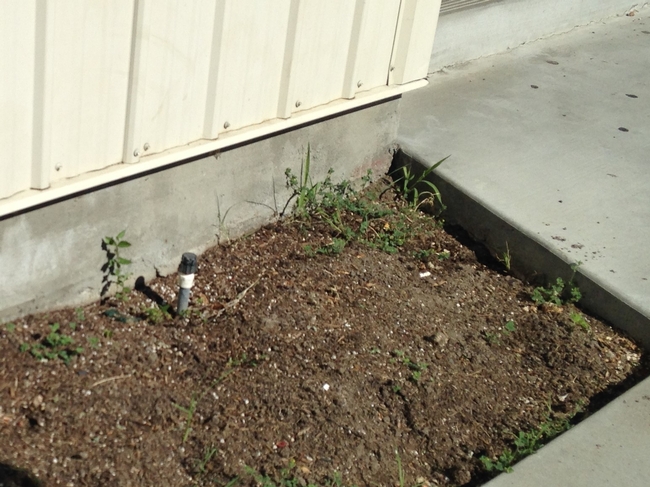
- Author: Ryan Daugherty
I was dealing with a gopher problem in a lawn awhile back and I came across another turfgrass pest that you may or may not be familiar with; a chafer beetle.
These white grubs are the immature larval form of a chafer beetle.
Here in California we deal mainly with the masked chafer (Cyclocephala spp.). Mature grubs have white or cream colored, C-shaped bodies, six legs on their upper half, and a chestnut brown head. They can be confused with the somewhat smaller black turfgrass ataenius larvae (Ataenius spretulus). To identify the difference between the two, look at the tip of the abdomen (the opposite end from the head) for the arrangement of bristles and overall anatomy, we call this the raster pattern. A chafer's raster will have a transverse anal slit with an indistinct pattern of bristles all over. An ataenius will have two distinct pad-like structures on the tip of the anal slit.
The chafer grubs feed on turf roots in early spring then stop around May to pupate with adults emerging around June to mate. Adults actually have non-functional mouthparts and so do not cause feeding damage, in fact they die of starvation shortly after laying eggs. Adults are about 3/4 inches long with golden brown bodies and they emerge during the night with a strong attraction to light. If you see adults during the summer, eggs are likely being laid in your grass. Eggs hatch around August and the grubs do most of their damage in September and October before moving deeper into the soil to overwinter until the spring.
Damage looks like drought symptoms in turf: brown, blueish, or gray spots, brittle straw colored grass, thinning stands, and footprinting. These symptoms are from the extensive root feeding of the grubs as the grass loses much of its ability to take up water. You may also see vertebrate feeding from birds or skunks that can cause further damage digging for the grubs. Spots of affected turf may be small, only being a foot or two across but may combine with other spots to form large sections of damaged turf. A hallmark of grub damage is that damaged turf can be peeled back from the soil like a carpet, due to the turf having no roots.
Insect damage in home lawns is rarer than you might think, with abiotic problems like poor irrigation, mowing, or fertility practices being a more likely culprit for a struggling lawn. If there is an insect pest make sure you correctly identify the insect before intervening with any control measures. Also remember that the presence of a pest doesn't always necessitate control. A healthy lawn can withstand damage from a few grubs and a robust lawn is always the best defense against pest damage.
Damaged turf can be helped by irrigating more frequently to keep soil moist around the lawns now shallow roots. Lawn aeration can also kill segments of grub populations. Reserve any kind of chemical intervention until you see 6 or more grubs per square foot. Several insecticides are available on the market for chafers or white grub control just look at the label. UC IPM has a page dedicated to masked chafers, but keep in mind the pesticides recommended there are for professionals.
Always read and understand the label of any pesticide you intend to use. Be careful to refrain from applying insecticides (especially broad spectrum) if there are flowering plants in and around the lawn; this includes weeds like clover or dandelions as it can harm beneficial insects like pollinators that may come into contact with them.


